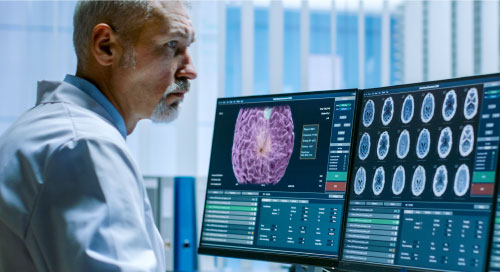Fill form to unlock content
Error - something went wrong!
Your content is just a step away. Please submit below.
Thank you!
AI and Computer Vision Boost Biomedical Research

Breakthroughs in biomedical research often come from understanding correlations and causality—the what and how of the body’s physiological processes.
Scientists make observations such as a higher rate of cancer or better reaction to vaccines by correlating data sets. They then research underlying reasons for these correlations. Systematically plodding through these cycles of biomedical research is tedious but rewarding work.
Now AI-driven computer vision applied to medical imaging accelerates discovery of data correlations. It finds problem points worth exploring much more quickly. In doing so, AI helps humans zero in on problems faster. And that can help human scientists arrive at life-changing medical solutions much more quickly.
AI Models in Medical Imaging
One use case is how Mayo Clinic uses AI and machine learning to profoundly enhance the capabilities of ultrasound imaging. As a starting point, the medical institution uses the latest technologies, tools, and products from Intel and Dell—the Intel® Geti™ platform and the Intel® OpenVINO™ toolkit running on Dell edge systems—to find kidney stones from endoscopy videos of the organ, and to assess Point of Care (POC) Ultrasound images for cardiac function.
Mayo Clinic’s work in the use of AI ultrasound imaging is a particularly useful case of the technology, says Alex Long, Global Head of Life Sciences Strategy at Dell Technologies, a solutions provider that offers an extensive product portfolio and comprehensive services. For too long, interpretation of ultrasounds has been subjective, prone to errors, and requires specialized training.
Visual #AI models, trained on banks of #data, can help providers offer more personalized care at the bedside. Augmenting care with AI can find anomalies faster, more accurately, and with minimal training. @DellTech via @insightdottech
But visual AI models, trained on banks of data, can help providers offer more personalized care at the bedside. Augmenting care with AI can find anomalies faster, more accurately, and with minimal training. Modern approaches which leverage pre-trained models and active learning enable the rapid development and deployment of these models. “Our care providers understand the benefit of using AI to aid in patient care, but in cases like the POC ultrasound, there wasn’t a viable AI model available,” says Dr. David Holmes of Mayo Clinic. His team of engineers leveraged interactive AI modeling tools to rapidly develop an AI solution that assess the quality of the images at the bedside in order to ensure the best images are used in the patient care.
The use of AI in medical imaging is about more than its capacity as a diagnostic tool. “It’s about leveraging visual AI to interpret imaging data and to accurately augment the capabilities of the human,” Long says. Diagnosticians trained to sift through files to find problems—evaluating mammograms to find early signs of breast cancer is a good example—can also benefit from AI guiding them to more places to evaluate. The advantage of AI is that it finds patterns that the human eye, due to confirmation bias, might miss.
A variety of additional scenarios in biomedical research can benefit from AI, especially if they involve imaging data. “It turns out there’s a lot of other medical systems that are visual in nature,” Long says. And they could all benefit from using AI as a tool to augment human abilities.
Collaboration Propels Innovation
A partnership between Intel and Dell Technologies enables these AI-driven breakthroughs. “The definition of community is a group of people with like-minded aspirations who are trying to achieve a goal together,” Long says. “We’re seeing a healthcare life sciences community being born between Dell and Intel.”
Collaboration between the two companies has evolved organically over many years, and Dr. Holmes’ work is one example of how the two bring their strengths to the table. The companies’ healthcare solution teams and their technology and product platforms enable collaborations with leading biomedical researchers and providers.
“The depth of our portfolio, the depth of our partnership, and the expertise in IT and infrastructure required to deliver” are what Dell brings to the table, Long says. In addition, Dell keeps in mind that the healthcare industry places heavy emphasis on privacy and protection of sensitive patient health information. “It’s not just about technology adoption to mitigate costs,” Long says, “it’s about technology to advance the human initiative of improved health. We’re passionate about really advancing the care of human beings.”
The Future of AI in Healthcare
The Mayo Clinic use case offers a glimpse of what is possible with AI models in biomedical research. We are just beginning to explore ways that AI can find correlations on visual imaging data, directing humans to new avenues for further exploration.
Researchers almost always try to find correlative data to drive conclusions, and “if you want something to identify a correlation, there’s nothing better than AI,” Long says. “I’m very excited about AI’s potential in accelerating diagnostics, improving patient care, and rapidly getting to understand the next wave of heuristics and treatments.”
When it comes to the human body, there’s a lot left to discover. It’s an exciting time to work at the intersection of technology and medicine because the volume of discoveries that AI can facilitate is simply mind-boggling. AI can train its eyes on years of data. The results are likely to be nothing short of revolutionary.
Edited by Georganne Benesch, Editorial Director for insight.tech.